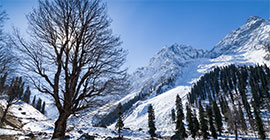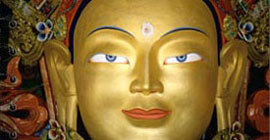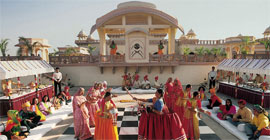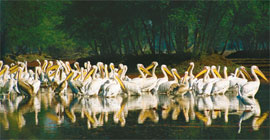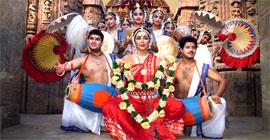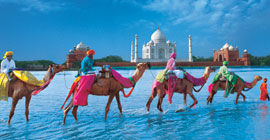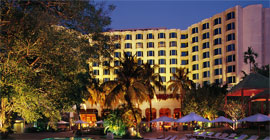TAJ MAHAL
The beautiful Taj Mahal in Agra India, is one of the seven wonders of the world. Built as a tomb for the Empress Mumtaz Mahal, the enchanting Taj Mahal Agra has come to symbolize eternal love. This romantic monument houses the tombs of Shah Jahan and Mumtaz Mahal and is considered the supreme example of Mughal architecture in India. Built of white marble, the Taj Mahal Agra is surrounded by green gardens, waterways and fountains and the River Yamuna. Tours to Agra to see the Taj Mahal are on the itinerary of every tourist to India. The Taj Mahal Agra is a mesmerizing sight that must be seen on tours to Agra, India, with Taj Mahal Agra.
HISTORY OF TAJ MAHAL
The construction of this marble masterpiece is credited to the Mughal emperor Shah Jahan who erected this mausoleum in memory of his beloved wife, Arjumarid Bano Begum; popularly known as Mumtaz Mahal, who died in A.H. 1040 (A.D. 1630).
Her last wish to her husband was "to build a tomb in her memory such as the world had never seen before". Thus emperor Shah Jahan set about building this fairy tale like marvel.
The construction of Taj Mahal was started in A.D. 1632 and completed at the ended in 1648 A.D. For seventeen years, twenty thousand workmen are said to have been employed on it daily, for their accommodation a small town, named after the deceased empress- 'Mumtazabad', now known as Taj Ganj, was built adjacent to it.
Amanat Khan Shirazi was the calligrapher of Taj Mahal, his name occurs at the end of an inscription on one of the gates of the Taj. Poet Ghiyasuddin had designed the verses on the tombstone, while Ismail Khan Afridi of Turkey was the dome maker. Muhammad Hanif was the superintendent of Masons.
The designer of Taj Mahal was Ustad Ahmad Lahauri. The material was brought in from allover India and central Asia and it took a fleet of 1000 elephants to transport it to the site. The central dome is 187 ft. high at the centre.
Red sandstone was brought from Fatehpur Sikri, Jasper from Punjab, Jade and Crystal from China, Turquoise from Tibet, Lapis Lazuli and Sapphire from Sri Lanka, Coal & Comelian from Arabia and Diamonds from Panna. In all 28 kind of rare, semi precious and precious stones were used for inlay work in the Taj Mahal.
The chief building material, the white marble was brought from the quarries of Makrana, in distt. Nagaur, Rajasthan. Copies of orders (farmans) issued to Raja Jai Singh, for the purpose by Shah Jahan, can be seen in the Taj Museum.
Taj Mahal's outer court, also known as Jilo Khana, was formerly used both as a bazar and a caravansarai (Rest house). On the south-east and south-west comers are the tombs of Sirhindi Begum and Satiunnisa Khanum. The Taj has a jewel-like quality.
The shadow and light play demonstrates its many moods.
Some feel the Taj is best seen on a full moon night, others find it ethereal at dawn while some insist that it is sensuous at sunset.
TAJ MAHAL LOCATION
Agra, the city of the Taj Mahal and once the capital of the Mughal empire, has several monuments which display the splendour of Mughal architecture. It was here that Babar, the founder of the dynasty, had the first formal Persian garden laid out on the banks of the river Yamuna. Akbar, his grandson, raised the towering ramparts of the great Red Fort, within whose walls Jahangir built rose-red palaces, courts and gardens, and which Shahajahan embellished with marble mosques, palaces and pavilions of gem-inlaid white marble.
Agra is mentioned in the ancient epic Mahabharata as Agraban, the sister city of the more prominent Mathura. Agra was established in 1475 by Badal Singh and came into its own when Sikander Lodhi of the Lodhi dynasty chose it for his capital because of its proximity to the Yamuna. Babur defeated the Lodhis to capture not only Agra but also to lay the foundation of the Mughal empire.
In the mid-16th and earlier 17th centuries, Agra witnessed a frenzied building activity and it was during this time that the symbol of love, the Taj Mahal, was built. The buildings made during this era were purely in the contemporary Mughal style and of very high quality. Besides the monuments, Agra is worth a visit for the masterpieces of craftsmen recreating the glory of the Mughal period and for the Mughlai cuisine, the aroma of which fills the narrow lanes of Agra.
Banks of Yamuna
On the banks of river Yamuna, rises the crescent-like Agra Fort. Designed and built by Emperor Akbar in 1565 A.D., the fort is surrounded by a 70 foot high wall. It houses the beautiful Pearl Mosque and numerous palaces including the Jahangiri Mahal, Khas Mahal, Diwan-i-Khas, Diwan-i-Am, Machihi Bhawan and Moti Masjid. The fort has four gates and is enclosed by a double battlemented wall of red sand stone.
BUILDING OF TAJ MAHAL
Besides the miraculous architectural features and the elaborate ornamentation of the Taj Mahal, many additional features, which can often be overlooked, help complement and enhance this spectacular monument.
Background
Unlike other Mughal tombs, the garden of the Taj Mahal has been laid out entirely in front of the tomb and does not play any part in the 'background'. Instead, the background has been provided by the sky. This background is not constant; it changes its colour and texture more than often, and the Taj is always presented in a variety of tints and moods. Its shades are subtly reflected on the white marble surface of the Taj Mahal which changes its colour and complexion accordingly.
Marble
The Makrana marble used is of such a nature that it takes on incredibly subtle variations of tint and tone, according to the changes in the light, thus picturing the passing colour of the moment.
Soaring Effect
The colossal height of the tomb, along with its pyramidal appearance (which is obtained by the receding plinths, the square tomb and the bulbous dome, along with the pilasters surmounted by pinnacles, the tapering minarets and the decreasing volume of the dome culminating in a kalasa) give it a soaring effect. It appears as if it is about to rise into the sky...an ethereal quality full of lightness and grace.
Correction of Illusionary Effects
The indigenous builders of the Taj Mahal fully understood the deceptive nature of the human eye. They knew that the reality and its perception and interpretation thereof differed. The plinth of the main tomb is 2'10'' high on an average. But the height varies at different places, particularly the central point between two piers being in each case 0.5" to 0.7" higher than the sides. This convexity has deliberately been given to the plinth in the centre of each arch, or else the building would have appeared as if it were falling down! The facades are not exactly at a right angle with the plinth, but are slightly inclined.
The finial is a stupendous crowning feature which measures nearly 10 meters!! The architect fully anticipated the apparent size which a finial would present from such a great height. It has therefore been very ingeniously been planned. These features of construction demonstrate the ability of the Indian architects to reconcile the illusionary effects created by distance and light.
TAJ MAHAL STORY
The story of Taj Mahal reflects the intensity of love. The fairy tale began when walking through the bazaar of Agra prince qhurram saw a girl. The girl was exceptionally beautiful. It was a love at first sight for both of them. After five years, on an auspicious day they were married and from that moment began the great epic of love.
Shah Jahan, "The King Of The World"
Prince qhurram was the fifth son of emperor Jahangir. He was the man of extraordinary brilliance, a great diplomat, a warrior and a lover of art. Once Jahangir wrote, "In art, in reason, in battle there is no comparison between him and my other children". In the honor of his numerous victories Jahangir entitled him as "Shah Jahan", "The King of the World". After Jahangir's death all his sons quarreled for the thrown, after fighting for years Shah Jahan killed all his brothers under suspicious circumstances and became the emperor, besides him stood his queen, comrade and confidante.
Mumtaz Mahal "The chosen one of the palace"
Shah Jahan titled her "Mumtaz Mahal", "The chosen one of the palace". A rare found combination of beauty and brain. She was her husband's best friend and confidante. She would counsel him in the diplomatic matters. She too was a great lover of art.
The End of the Fairy Tale
In 1631 Shah Jahan set up to berahanpur with his troops to subdue a rebellion, accompanied by Mumtaz Mahal Unfortunately during childbirth she suffered some complications and died. According to legend before dieing she extracted a promise from Shah Jahan that he would build a mausoleum as a tribute to their love.
The story of Taj Mahal begins Shah Jahan was obsessed to fulfill his wife's last wish. He invited the architects and artisans all over the world and planned for the building with absolute perfection. Taj Mahal was structured in Persian style combined with carvings of artisans called from Afghanistan and the garden designers from Kashmir. It took 22years to complete the Taj Mahal, a memento of love with the perfection of art. The carvings of Taj Mahal were decorated with very precious gemstones.
The story of Taj Mahal is unique in itself. It is an evidence that how the emotions and feelings are important to human life. The story of Taj Mahal is an example of devotion and faith. The story of Taj Mahal is a love story not found in papers but stands in the structural form. The story of Taj Mahal is rare.
TAJ MAHAL Architecture
The city of Agra is world famous for the Taj Mahal, built by the Mughal emperor Shahjahan in memory of his beloved wife. However, it is also famous for the Agra Fort, which is a veritable treasure trove of the Mughal architectural tradition.
The various buildings within this sprawling fort complex represent the assimilation of different cultures, which was the mark of the Mughal period.
MUGHAL STYLE OF ARCHITECTURE
The structure of Taj Mahal adheres to the Islamic style (Mughal style) of architecture, which flourished in India during the medieval period. The Islamic style of architecture is also referred to as the Indo-Islamic style of architecture.
This magnificent monument is set around a Charbagh or ‘four garden’ plan, which is split by watercourses - a reflection of the Persian style. The Taj Mahal itself is not set within the Charbagh but is located towards the far end of the enclosure near the bank of river Yamuna.
Taj Mahal is built on a high plinth, which has four tapering minarets at each corner. At the center of this plinth is an octagonal structure comprising of a central hall, with four smaller halls grouped around it.
A central bulbous dome stands atop the roof of the Taj that is surrounded by four chhatris (domed canopy, supported by pillars, mainly seen in Hindu or local monuments and sometimes in Islamic buildings).
The Taj Mahal is a two-storied structure, each having arched recesses with a highly decorated iwan in the middle. The tombs of Mumtaz Mahal and Shahjahan are actually located in the basement, while their replicas are placed directly above in the upper hall.
The Taj Mahal is entirely made of white marble and its pure white walls are decorated with exquisite pietra dura (stone inlay) work. It is said that different types of precious and semi-precious stones were used in the intricate inlay work done on Taj Mahal.
In spite of its massive proportions, Taj Mahal looks weightless and airy. Each section of this unique monument blends harmoniously with each other to create a perfect unit. The Taj Mahal and the gardens in front of it can be approached through an arched gateway.
TAJ MAHAL GARDEN
The Persian style garden
The lush green garden expands from the main gateway to the plinth, over which stands the tomb. The garden in essense is based on symmetry and geometrical measurements.
The Persian style garden has a close link with paradise, since Quran describes paradise as a beautiful garden.
Water garden
Through the centre of the garden runs the two marble canals with fountains and lined with cypress trees (symbolising death).
This divides the garden into four equal squares(Islam considers four to be a holy number), evoking the image of Islamic paradise that has rivers of water, milk, wine and honey flow. The stone paved pathways further subdivides each flower bed into 4, making total of 16 flower beds.
The mausoleum, unlike most mughal mausoleums, stands majestically at the north end just above the river and not at the central location. At the centre of the garden, in the mid of the tomb and the gateway, is a raised marble lotus shaped tank with a cusped and trefoiled border.
The tank has been arranged to provide a clear view of Taj in its water from any point in the garden. The view looks amazing with the reflection of Taj amidst the green cyprus trees .
Water devices and irrigation mechanism
Water in the canals was drawn from the river using purs, a system of drawing water manually from river using bucket and ropes. For irrigation the water from the overflowing canals was used.
The north-south canals had its water inlet through fountains and east-west canal had its water inlet through an interconnection with north-south canal.
MUMTAJ MAHAL
The story of Taj Mahal is inseparable from the life of Mumtaz Mahal who was the chief queen of Shahjahan. Prince Khurram, as Shahjahan was known before he became the Mughal emperor, was a handsome twenty-year-old man, when he was betrothed to Mumtaz.
It is said that the imperial capital of Agra was agog with the description of her beauty at the time of the betrothal. The maiden name of Mumtaz Mahal was Arjumand Banu Begum.
Prince Khurram had been married twice before he met and married Mumtaz Mahal. Mumtaz bore him 13 children and accompanied him wherever he went.
On June 17, 1631 Mumtaz Mahal breathed her last after delivering her 14th child, at the age of 39. Saddened by her sudden demise, Shahjahan resolved to immortalize their love.
It is said that Mumtaz Mahal on her deathbed had herself asked her husband to create a symbol of their love for posterity. Shahjahan is said to have accepted her proposal and resolved to do so.
According to another school of thought however, no such conversation transpired between the two and the grief stricken emperor decided to build the Taj Mahal to immortalize the memory of his beloved queen, on his own.
Either, way the Taj remains as whimsical in conception as it is majestic in construction. Before the construction of Taj Mahal began, Mumtaz Mahal was given a temporary burial in the Zainabadi garden in Burhanpur for a period of six months, before the body was exhumed and brought to Agra, for the final burial.
Taj Mahal is a monument of love. Taj is the pride of India. The story behind Taj Mahal is also as beautiful as the monument. It is the love story of a prince and a beauty girl that turned into a legend.
How to Reach Taj Mahal
Indian Airlines (Domestic Airline in India) runs daily flights from Delhi to Agra. Kheria Airport (Airport of Agra) is about 6 km from the Agra city centre and is easily accessible by taxis and auto-rickshaws at nominal rates.
BY RAIL / TRAIN
Agra is well connected by excellent train services to Delhi such as The Shatabdi Express (2 hrs), Taj Express (2.5 hrs), Intercity Express (3 hrs).
Railway Stations:
Agra Cantt Rly Stn
Raja-ki-Mundi Rly Stn
Agra Fort Rly Stn
BY ROAD
Express bus services (a/c and non-a/c) are available from Delhi, Jaipur, Lucknow, Gwalior, and Jhansi. For those driving to Agra, the distances are:
Mathura (Pilgrimage Destination) - 58 kms.
Bharatpur (Bird Sanctury) - 60 kms.
Gwalior (Historical Destination) - 118 kms
Delhi (Capital City of India) - 203 kms
Jaipur (Cultural & Historical Destination) - 236 kms.
Khajuraho (Historical Destination) - 393 kms.
Excurstion Taj Mahal
Bharatpur Bird Sanctuary
This magnificent bird haven in actual came into being paradoxically as a duck shooting preserve for Maharaja Suraj Mull of Bharatpur. He transformed the shallow depression formed by the confluence of River Gambhir and River Banganga into a reservoir by damming the rainwater in monsoons. Flooding of water created shallow wetland ecosystem causing it to be a perfect habitat for an astounding variety of birds.
Delhi
Delhi is the capital of India since old times. Delhi's history dates back to the first millenium BC, when it was known as Indraprastha. The Tomar Rajputs built Lal Kot, the core of the first of Delhi's seven cities. It is the epicenter of the nation's politics, economy and culture. History is alive and throbbing in Delhi, the capital of India.
Gwalior
Steeped in the splendour of its past, the ancient capital of Gwalior has yet made a successful transition into a modern Indian city, vibrant and bustling. A multitude of reigning dynasties, of the great Rajput clans of the Pratiharas, Kacchwahas and Tomars have left indelible etchings of their rule in this city of palaces, temples and monuments.
Jaipur
Jaipur is 260 km from Delhi and 240 km from Agra and forms the most chosen tourism golden triangle of Delhi, Agra and Jaipur. It a bustling capital city and a business centre with all the trapping of modern metropolis but yet flavoured strongly with an age-old charm that never fails to surprise a traveller.
Mathura
A long line of picturesque ghats - with their steps leading to the water's edge, arched gateways and temple spires extending along the right bank of the River Yamuna, emphasis the sacred character of the town of Mathura. The birth place of Lord Krishna, "the best known, best loved and most complex of Lord Vishnu's manifestations" - Mathura is today an important place of pilgrimage.
Vrindavan
What is comparatively a matter of detail is that Vrindavan is believed to have been the stage on which Krishna performed his famous romantic and sportive roles. Unlike busy Mathura. Vrindavan seems perpetually to be dreaming and imaginatively, re-living its romantic past.







